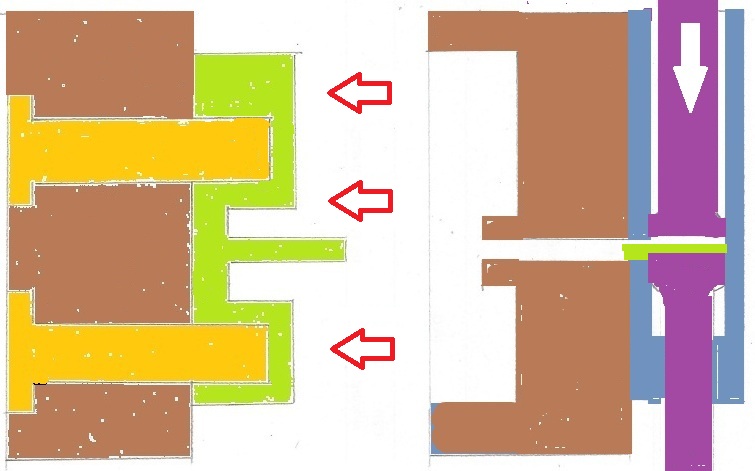The die-casting mold consists of two parts, namely, the covering part and the active part, and the part that they combine is called the typing line. In hot chamber die casting, the cover part has casting, and in cold chamber die casting. From here, the molten metal can enter the mold. whose shape matches the injection mouth in the hot chamber or the injection chamber in the cold chamber. The active part usually includes a push rod as well as a flow path, which is a channel between the pouring gate and the mould cavity, through which the molten metal enters the mould cavity. The cover part is usually attached to the fixed plate or front plate, while the active part is attached to the movable plate. The mold chamber is divided into two mold cavity inserts that are separate parts and can be relatively easily removed or installed from the mold by bolts.
The mold is specially designed, and the casting remains in the active part when the mold is opened. This pushes the active part out the cast, which is usually driven by a pressing plate, and accurately drives all the rods simultaneously with the same size, so that the cast will not be damaged. When the casting is rolled out, the plate shrink retracted all the rods back for the next die casting. Since the casting is still removed at high temperature, only enough putter quantity is sufficient to ensure that the average pressure to each putter is small enough not to damage the cast. But the push rod still leaves traces, so it must be carefully designed so that its position does not have much impact on the operation of the casting.
Other parts in the mold include the type core skateboard, etc. Type cores are parts used to open or open the casting, and they can also be used to add detail to the casting. There are three main types of type core: fixed, active and loose type. The direction of the fixed core is parallel to the direction of the cast removal die, and they are either fixed or attached to the die. The movable core can be arranged in any direction other than the removal direction, and the movable core must be removed from the mould chamber. The slider is close to the movable core, the difference being that the slider can be used to create inverted concave surfaces. The use of type cores and sliders in die-casting greatly increases the cost. Loose cores, also known as removal blocks, can be used to create complex surfaces, such as threaded holes. Before each cycle begins, the slider should be installed manually and then rolled out with the cast. Then take out the loose core. Loose cores are the most expensive because it takes much labor to make, and it increases the cycle time.
The exits are usually thin and long (about 0.13 mm), so molten metal ols quickly to reduce waste. The burst vent is not required in the die-casting process, because the molten metal pressure is very high, which ensures a continuous flow into the mold from the pouring gate.
Due to temperature, the most important material characteristics for molds are thermal and vibration resistance and softness, while other characteristics include quenching ability, cutting ability, heat and crack resistance, weldability, availability (especially for large molds) and cost. The die life depends directly on the temperature of the molten metal and the time of each cycle. molds used in die casting are usually made using hard tool steel, because cast iron cannot withstand the huge internal pressure, which also leads to the high cost of the mold opening. Metal die-cast at higher temperatures requires harder alloy steel.
Major defects that can occur during die-casting include wear and erosion. Other defects include hot cracking and thermal fatigue. Hot cracks occur when the mold surface is defective due to the large change in temperature. After using too many times, the defects on the mold surface will produce thermal fatigue.

